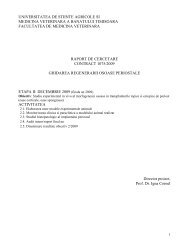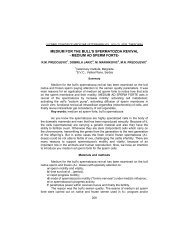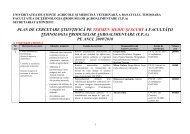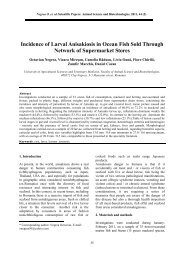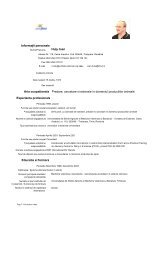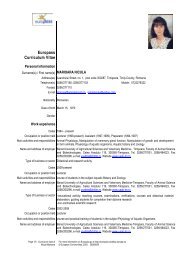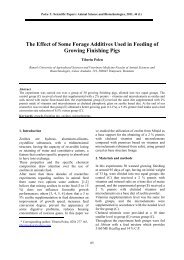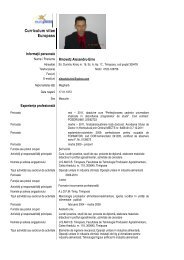Stanca Claudia., Cârstea V. B., Ilie Daniela, Gocza Elen
Stanca Claudia., Cârstea V. B., Ilie Daniela, Gocza Elen
Stanca Claudia., Cârstea V. B., Ilie Daniela, Gocza Elen
Create successful ePaper yourself
Turn your PDF publications into a flip-book with our unique Google optimized e-Paper software.
Lucrări ştiinţifice Zootehnie şi Biotehnologii, vol 40(1), (2007), Timişoara<br />
MODELS FOR MOUSE CHIMERA PRODUCTION:<br />
AGGREGATION OF ES CELLS WITH CLEAVAGE STAGE<br />
EMBRYOS<br />
MODELE DE PRODUCERE A HIMERELOR DE ŞOARECE:<br />
AGREGAREA CELULELOR ES CU EMBRIONI ÎN STADIUL<br />
DE CLIVAJ.<br />
STANCA CLAUDIA**., CÂRSTEA V. B***., ILIE DANIELA*,<br />
GOCZA ELEN***, VINTILĂ I.**<br />
*Research and Development Station for Bovine Raising - Arad<br />
**Faculty of Animal Science and Biotechnology, Timişoara, România<br />
***Agricultural Biotechnology Center, Gödöllő, Hungary<br />
In a mutant ES cells↔ wild-type embryo chimera, ES cells behave more like epiblast<br />
cells. They can contribute to the primitive ectoderm layers, which give rise to all the<br />
embryonic tissues and some extraembryonic tissues (Beddington and Robertson,<br />
1989), but not to trophectoderm or primitive endoderm. Using transgenic ES cell<br />
lines, aggregated with cleavage stage host embryo, ES cells can integrate randomly<br />
in the embryo proper. If they will be take part in the formation of ICM (inner cell<br />
mass), it will be possible to obtain germline chimera animals. To generate ES cells<br />
↔ cleavage stage host embryo chimeras, we used (CD-1) mice as donors of host<br />
embryos as well as recipients of manipulated embryos. For chimera production, we<br />
used fluorescent-labeled ES cell line (CD1/EGFP), because in this case we can<br />
follow the fate of ES cells during the embryonic development. We produced the<br />
chimers using “aggregation chimera technique”. 8 cells stage zona pellucida free,<br />
mouse embryos were aggregated in an aggregation plates, with a clump of ES cells<br />
(10 – 15 cells. The chimera embryos were cultivated for 24 hours in the incubator<br />
(at 37 °C, 5% CO2 in air). The chimera blastocysts resulted after cultivation, were<br />
transferred to the uterus of the 2.5-dpc pseudo pregnant females.<br />
Key words: Es cells, diploid, pseudo pregnant, aggregation<br />
Introduction<br />
Aggregating ES cells with diploid eight-cell stage embryos is a simple and<br />
inexpensive means of introducing genetic alterations into mice. Circumventing the<br />
transfer of non-chimeric embryos after the aggregation is completed makes the<br />
technology more efficient and reduces animal space requirements. A green<br />
fluorescent ES cell line now provides a convenient tool to do so, since the<br />
incorporation of ES cells into preimplantation stage embryos can be monitored<br />
prior to their transfer. ES cell contributions to the embryo can vary, with ES cell<br />
contributions into morula and blastocyst stage embryos after overnight incubation<br />
195
of eight-cell stage embryo– ES cell aggregates depicted. While ES cells will<br />
preferentially contribute to the ICM, where they can either represent the entire ICM<br />
or just a portion of it they will also occasionally be present in the trophoblast ,<br />
though it is unclear whether this is a real contribution to the trophoblast lineage or<br />
these cells are trapped in this region of the embryo never to proliferate. Studying<br />
postimplantation stage chimeric embryos of this type will possibly answer this<br />
question.<br />
Materials and Methods<br />
Equipment and reagents<br />
8-cell stage embryos after overnight culture<br />
KSOM and M2 medium in 1 ml syringe wit 26G needles<br />
Embryo-tested mineral oil (Sigma)<br />
Aggregation needle (BLS Ltd., Hungary)<br />
70% Ethanol<br />
35 mm tissue culture plates for chimera production (Greiner)<br />
30, 60, 100 mm tissue culture plates for fibroblast and embryonic stem<br />
cells (Greiner)<br />
Dissecting microscope<br />
Acid Tyrode’s solution<br />
ES cell line derivation and cultivation<br />
For routine ES cell cultivation, the method of Robertson et al., [1] was<br />
used without any modification.<br />
Chimera production<br />
For chimera production we used two components: embryos from CD1<br />
mouse strain, as host embryos, and EGFP expressing ES cells (CD1/EGFP) [2].<br />
We used CD1 mice as donors of host embryos as well as recipients of manipulated<br />
embryos and as foster mother.<br />
Micro drops of KSOM medium [3] were placed into a 35-mm tissue<br />
culture dish and covered immediately with embryo tested mineral oil. The<br />
aggregation needle was washe with 70% ethanol and deep depressions were<br />
created by pressing it into the bottom of the plastic dish.1.5 days old embryos were<br />
collected from the oviduct of superovulated females [4]. Superovulation was<br />
induced by PMSG (pregnant mare serum gonadotrophin) and HCG (human<br />
chorionic gonadotrophin) injections. On the first day at 13 o’clock the females<br />
were injected with 7.5 IU PMSG (pregnant mare serum gonadotrophin) and 48<br />
hours later with 7.5 IU HCG (human chorionic gonadotrophin) (i.p.). After that<br />
they were put together with the males. Next day in the morning, the mating was<br />
controlled by checking the plugs. The day of the plug was considered the first day<br />
of pregnancy (Day 0.5). On the second day of pregnancy 2-cell stages embryos<br />
were washed from the oviduct using M2 medium, then the embryos were incubated<br />
in a thermostate, in microdrops of KSOM in a 35-mm tissue culture dish, at 37C°<br />
196
and 5% CO2 until next day, when they reached the eight-cell stage, the first<br />
component of chimera production.The zona pellucida of the eight-cell stage<br />
embryos was removed by acidic Tyrode’s solution [4]. The zona free embryos<br />
were placed individually into one depressions of the aggregation plate [4].On the<br />
day of experiment, the medium was removed from the ES cell plates prepared for<br />
aggregation. First, the ES cells were washed with Ca/Mg-free PBS, and then a<br />
minimal amount of trypsin (SIGMA) was added just to cover the cells. The plate<br />
was placed into the incubator for five minutes. After that, 2 ml of culture medium<br />
was added to stop the activity of trypsin. 100-200 clumps of loosely connected<br />
cells were picked and transferred into a large drop of KSOM medium. Clumps of<br />
10-15 cells were picking up from medium and transferred aside the zona free<br />
embryo. After 24 hours most aggregates were at the late morula/early blastocyst<br />
stage and were transferred into the uterus of pseudo pregnant females [1, 3].<br />
Results and Discussions<br />
All the experiments started with diploid host embryos produced by super<br />
ovulated CD1 females. We obtained 25-30 embryos from one female. When we<br />
used not super ovulated females, the number of embryos was lower, around 10. In<br />
the firs experiment we injected 7 females, 3 females were plug positive and we<br />
flushed from the oviducts ~ 100 embryos at 2 cells stage. After overnight culture,<br />
the embryos developed to 8-cells stage, we got ~ 80 embryos. Form the total<br />
amount of 64 chimera morula; we transferred 30 in to the uterine horns of pseudo<br />
pregnant females. Five newborn chimera mice have been born and two of them<br />
survived the adulthood. In the second experiment, we inject 5 CD1 females, two of<br />
them were plug positive and we flushed from the oviducts ~ 85 embryos at 2 cells<br />
stage. After overnight culture, the embryos developed to 8-cells stage, we got ~ 65<br />
embryos. Form the total amount of 30 chimera morula; we transferred 24 in to the<br />
uterine horns of pseudo pregnant females. The pregnant females were subjects for<br />
caesarian at 13.5 day of pregnancy. We could get 9 implantations.<br />
Table 1<br />
Data regarding embryo manipulation:<br />
Injected female genotype CD1 CD1<br />
Injected female number 7 5<br />
Date of plug 05. 24. 2006 05. 26. 2006<br />
Number of plug+ female 3 3<br />
Number of recipiens female 2<br />
Number of gained embryos 110 100<br />
Number of cultured 2 cell stages embryos 100 85<br />
Number of good qualiti 2.5 day old<br />
embryos 80 65<br />
Number of produced chimeras 64 30<br />
Type of chimeras CD1xCD1/EGFP CD1xCD1/EGFP<br />
197
Table 2<br />
Data regarding embryo transfer<br />
Number of transferred chimeras 30 24<br />
Sign of recipinet females TR1, TR2 TR1, TR2<br />
Date of cesarian section 06. 11 06. 06<br />
Newborn<br />
5 Cesarian<br />
days<br />
at 13.5<br />
Living newborn 2 -<br />
Resorption (deciduum)<br />
TR1: R(2), L(3)<br />
TR2: R(2), L(1)<br />
Conclusions<br />
198<br />
TR1: R(3), L(1)<br />
TR2. R(1), L(4)<br />
Trough this experiments we tried to develop optimal methods, which<br />
necessary for succesful embryos flashing at 2 cell stage:<br />
1. The time between sacrificing embryo donors and placing the embryos in culture<br />
dishes should be kept to a minimum value, ideally no more than 20-30 minutes.<br />
2. It is important to know that 2-cell stage embryos are more sensitive than<br />
morulae.<br />
3. From the obtained results we can conclude that the KSOM medium is the<br />
appropriate medium for 2 cell stage CD1 embryo cultivation.<br />
4. At chimera production, it is very important to place the ES cell clumps into the<br />
depressions, nearly aside the host embryos. In this case, we can be sure that they<br />
can form aggregate and the chimera morulas could not attached each other
Acknowledgements:<br />
This work was supported in part by Hungarian-Romanian Intergovernmental<br />
Project, No. C18001/09.01.2006.<br />
Bibliography<br />
1 Nagy A., Gertsensten M., Vintersten K. And Behringer R. (2003),<br />
Manipulating the Mouse Embryo; A Laboratory Manual. 3rd edition, Cold<br />
Spring Harbor Press, Cold Spring Harbor, New York.<br />
2 Robertson, E.J. (Editor) (1987) Teratocarcinomas and Embryonic Stem<br />
Cell: Practical Approach IRL Press; pp. 102-104<br />
3 Nagy, A., Rossant, J., Nagy, R., Abramow-Newerly, W. And Rode, J.C.<br />
(1993). Derivation of completely culture-derived mice from early-passage<br />
embryonic stem cells. PNAS 90:8424-8428.<br />
4 Hadjantonakis Ak, Macmaster S, Nagy A. (2002), Embryonic stem cells<br />
and mice expressing different gfp variants for multiple non-invasive reporter<br />
usage within a single animal. BMC Biotechnol. 11/2(1):11.<br />
5 <strong>Stanca</strong> <strong>Claudia</strong>, Ghişe Gh., <strong>Ilie</strong> <strong>Daniela</strong>, <strong>Cârstea</strong> B., Nichita Mihaela,<br />
Vintilă I. (2005) A simple and efficient techinque for production of<br />
multiparental mouse embryo Lucrări Ştiinţifice, Zootehnie şi Biotehnologii,<br />
vol XXXVIII, Timişoara. ISSN 1221-5287, pag. 837 – 842.<br />
199
MODELE DE PRODUCERE A HIMERELOR DE ŞOARECE:<br />
AGREGAREA CELULELOR ES CU EMBRIONI ÎN STADIUL<br />
DE CLIVAJ<br />
STANCA CLAUDIA., CÂRSTEA V. B., ILIE DANIELA, GOCZA ELEN,<br />
VINTILĂ I.<br />
*Research and Development Station for Bovine Raising - Arad<br />
**Faculty of Animal Science and Biotechnology, Timişoara, România<br />
***Agricultural Biotechnology Center, Gödöllő, Hungary<br />
La himerele de tip celule ES ↔ embrioni, celulele ES funcţionează mai mult ca celule<br />
epiblastice. Ele pot contribui la formarea ectodermului primitiv, care dă naştere la toate<br />
ţesuturile embrionare şi la unele ţesuturi extraembrionare (Beddington şi Robertson,<br />
1989), dar nu la trofectoderm sau la endodermul primitive. Folosind linii de celule ES<br />
transgenice agregate cu embrioni în stadiul de clivaj, celulele ES se pot integra la<br />
întâmplare în embrionul propriu. Dacă ele vor lua parte la formarea masei interne de<br />
celule, va fi posibilă obţinerea de animale himeră germinale. Pentru a genera embrioni<br />
himeră de tip celule ES ↔ embrion gazdă în stadiul de clivaj, am folosit şoareci din linia<br />
CD1 ca si donatori de embrioni şi ca recipienţi ai embrionilor manipulaţi. Pentru<br />
producerea de himere am folosit o linie de celule florescentă (CD1/EGFP), pentru ca în<br />
acest caz putem urmări soarta celulelor ES pe parcursul dezvoltări embrionare. Noi am<br />
produs himere folosind „tehnica de agregare”. Embrioni de 8 celule fără zonă pelucidă au<br />
fot agregaţi, în plăcuţe de agregare, cu 10 – 15 celule ES. Embrionii himeră au fost<br />
cultivaţi pentru 24 de ore în incubator (la 37 °C, 5% CO2 în aer). Blastociştii himeră<br />
rezultaţi după cultivare au fost transferaţi în coarnele uterine ale femelelor pseudo<br />
gestante.<br />
Cuvinte cheie: celule ES, diploid, pseudo gestante, agregare.<br />
200



